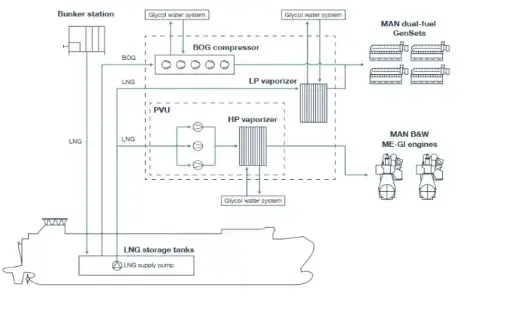Revolutionizing Marine Propulsion: Low-Pressure LNG Advantages
The adoption of low-pressure LNG fuel supply systems marks a significant leap forward in marine propulsion technology. These systems offer numerous advantages over traditional high-pressure alternatives, making them an attractive option for shipowners and operators looking to enhance their fleet's performance and environmental footprint.
Simplified System Design and Operation
Low-pressure LFSS designs streamline the fuel delivery process, reducing the complexity of onboard systems. This simplification translates to lower installation costs, easier maintenance, and improved reliability. The reduced pressure requirements also mean less strain on components, potentially extending the lifespan of critical system parts.
Enhanced Safety Features
Safety is paramount in maritime operations, and low-pressure LNG systems offer inherent safety advantages. The reduced operating pressure minimizes the risk of leaks and associated hazards, providing peace of mind for crew members and operators alike. Additionally, these systems often incorporate advanced monitoring and control technologies, further enhancing their safety profile.
Compatibility with Existing Engine Technologies
One of the most significant advantages of low-pressure LNG fuel supply systems is their compatibility with Otto-cycle engines. This compatibility allows for easier retrofitting of existing vessels, enabling shipowners to upgrade their fleets without the need for complete engine replacements. This flexibility is crucial in accelerating the adoption of LNG as a marine fuel across diverse vessel types.
Emission Reduction Potential of Low-Pressure LNG Systems
The environmental benefits of low-pressure LNG fuel supply systems are substantial, positioning this technology as a key player in the maritime industry's efforts to reduce its carbon footprint and meet stringent emission regulations.
Significant Reduction in Greenhouse Gas Emissions
LNG as a fuel offers remarkable reductions in greenhouse gas emissions compared to conventional marine fuels. Low-pressure systems optimize the combustion process, further enhancing these environmental benefits. Studies have shown that LNG can reduce CO2 emissions by up to 25%, with even greater reductions in other pollutants such as sulfur oxides and particulate matter.
Compliance with IMO 2020 and Future Regulations
The implementation of low-pressure LNG Fuel Supply Systems helps vessels easily comply with the International Maritime Organization's (IMO) 2020 sulfur cap and positions them well for future, more stringent environmental regulations. This forward-thinking approach ensures that vessels equipped with these systems remain compliant and operational for years to come.
Reduced Noise and Vibration
An often-overlooked benefit of low-pressure LNG systems is their contribution to reducing noise and vibration levels onboard. This not only improves the working conditions for crew members but also minimizes the acoustic impact on marine life, addressing growing concerns about noise pollution in our oceans.
Retrofitting Existing Vessels: Low-Pressure LNG Conversion Guide
The process of converting existing vessels to low-pressure LNG fuel systems is a complex but increasingly common undertaking. This guide outlines key considerations and steps in the retrofitting process, highlighting the importance of careful planning and expert execution.
Feasibility Assessment and Planning
The first step in any retrofit project is a comprehensive feasibility study. This involves assessing the vessel's current configuration, available space for LNG tanks and associated equipment, and the potential impact on cargo capacity. Engineers must also consider the vessel's operating profile to ensure that the LNG system can meet its fuel requirements effectively.
System Design and Integration
Once feasibility is established, the next phase involves detailed system design. This includes selecting appropriate LNG tanks, vaporizers, and control systems. The integration of these components with the existing engine and ship systems requires careful planning to ensure optimal performance and safety. Companies like TSC specialize in customizing low-pressure LFSS to fit diverse vessel types and operational requirements.
Installation and Commissioning
The installation phase typically occurs during a scheduled dry-docking period to minimize operational disruption. This stage involves the physical installation of LNG tanks, piping systems, and control equipment. Following installation, a rigorous commissioning process is undertaken to ensure all systems function correctly and safely before the vessel returns to service.
Crew Training and Operational Procedures
A crucial aspect of any LNG retrofit is comprehensive crew training. This includes familiarization with new equipment, safety procedures, and emergency protocols specific to LNG operations. Developing and implementing new operational procedures is essential to ensure the safe and efficient operation of the converted vessel.
In conclusion, the adoption of low-pressure LNG fuel supply systems represents a significant step forward in marine propulsion technology. These systems offer a compelling combination of environmental benefits, operational efficiency, and compatibility with existing vessel designs. As the maritime industry continues to evolve towards more sustainable practices, low-pressure LFSS technology is poised to play a crucial role in shaping the future of shipping.
Are you ready to transform your fleet with cutting-edge LNG fuel supply systems? CM Energy, with its expertise in marine energy solutions and global life-cycle services, is your ideal partner in this journey towards sustainable shipping. Whether you operate bulk carriers, chemical tankers, or specialized vessels like VLECs, our team can provide tailored solutions to meet your specific needs. Don't miss out on the opportunity to lead in environmental stewardship and operational efficiency. Contact us today at info.cn@cm-energy.com to explore how our innovative LNG fuel supply systems can revolutionize your maritime operations.
References
- International Maritime Organization. (2020). "Sulphur 2020 – cutting sulphur oxide emissions."
- DNV GL. (2019). "Maritime Forecast to 2050: Energy Transition Outlook 2019."
- Society for Gas as a Marine Fuel (SGMF). (2021). "LNG as a Marine Fuel - Safety and Operational Guidelines."
- Wärtsilä Corporation. (2020). "LNG as a Marine Fuel: Challenges and Opportunities."
- American Bureau of Shipping (ABS). (2021). "Guide for LNG Fuel Ready Vessels and Barges."
- Marine and Port Authority of Singapore. (2020). "Technical Reference for LNG Bunkering in Singapore."


